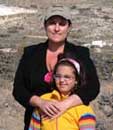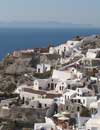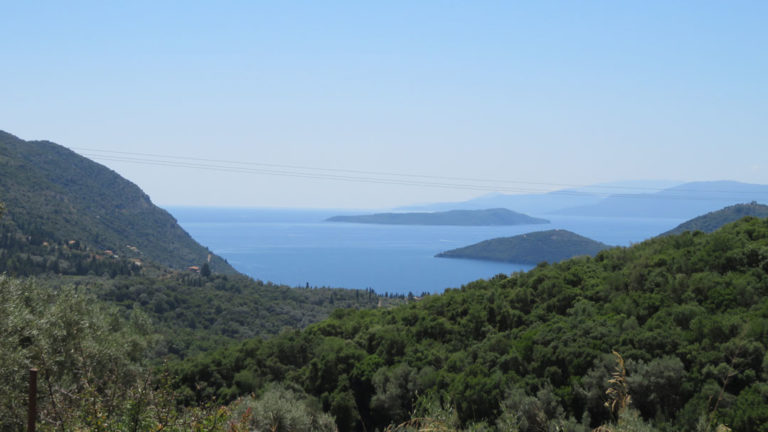Many great wines have their foundations in volcanic soils. Alsace’s Thann yields exuberant wines in the hands of Humbrecht and Schofitt. Across the Rhein in Baden’s Kaiserstuhl a number of winemakers achieve consistently good results from Pinots Noir and Gris. Madeira’s decomposed pumice soils are considered the best that island has to offer. Sections of California’s Napa and Sonoma Valleys take their power from the influence of the volcanic activity of eons past. Add to this list the island of Santorini of Greece’s Cyclades island archipelago.

Santorini is a half-circle shaped volcanic island mostly precipitously steep on its eastern rim, tapering off to gentle hills and gullies in the south, then large swathes of low-lying land ending at rocky beaches. The soil is comprised entirely of volcanic rocks, pumice, lava, and ash in several stages of decomposition. The soil’s low pH helps to create the impression of the wines’ high acidity in check. Vines are sulfured twice annually, the only spraying needed.
Organic viticulture here is de facto as the dry, windy climate keeps the typical vineyard scourges at bay. No problems of protein haze exist in the finished wines as the fertility of the soils is zero, necessitating only a touch of bentonite for clarification. Due to the low soil and wine pH, wines require less sulfur than normal both in vinification and bottling.

600 hectares of vineyards are cultivated–all phylloxera-free–with the northern areas harvested up to two weeks later than those in the larger, more southerly-facing, southern part of the island. The north winds are cooler than those from the south, adding to the claim that the northern vineyards produce better quality than those from the south. The greatest concern for growers is the spring winds which can whip the sand to hurt the young shoots, dramatically decreasing its potential for new grapes. This windiness necessitates a unique pruning of the plants protecting the buds and young leaves from the strong winds. This concentric-ringed basket style of training helps retain the evening’s humidity in the sunny & warm days, moisture which is evenly distributed to the vine from its retention in the pumice.
A problem with this ancient growing method is those grapes closest to the soil ripen earlier than those further away if influenced more by temperature, later if influenced more by the sun. At 60-70 years, they’re cut at the base and allowed to re-establish themselves as often as six times. Therefore, base material of rootstock and bottom stalk are of unknown age–some perhaps over four centuries. It’s difficult to purchase vineyards here, so selection has rarely been done wholesale and selection of the three principle white grapes of Assyrtiko, Aidani, and Athiri has traditionally been massale. Much replanting that takes place is in the ancient provinage method of bending a cane from an existing shoot into the ground in order to begin a newly-producing vine.
Hygroscopic capacity of these soils is very low. When heavy rainfalls occur the soil’s draining capacity is so high that the vines profit only from a fraction of the rain. To compensate, roots are long with the many as deep as seven meters. Finer roots are found in the upper layers to capture the sea fog’s moisture. During the long summers this fog, and relatively high ambient night humidity, are the only source of water for Santorini’s vineyards.

On the whole, yields on Santorini average 25hl/ha while in lesser vintages winemakers struggle to reach 15hl/ha. White wines, dry and sweet, rarely undergo malolactic conversion as malic acid is found in quantities so minute as to make this enzymatic reaction all but impossible without it being forced. Besides, the dominant Assyrtiko has a tendency to oxidize, apparent in its aged, sweet Vinsanto form. Due to a preponderance of the more stable tartaric v. the less stable malic acid, coupled with the low pH drawn from being grown on Santorini’s volcanic soils, these grapes produce remarkably stable wines.
Thalassitis winery’s Prof. Yannis Paraskevopoulos spoke of having tasted Santorini wine dated to 1847 provided to Dr. Stavroula Kourakou, the former president of the OIV, for a tasting in 2000. She invited 10 oenologists who work with the island’s wines, including Paraskevopoulos, who walked away convinced of the wisdom of having set up shop there several years before. Assyrtiko seeds dating to the 16th century have been found at the Akrotiri archaeological site on the southern part of the island, supporting the claim that this variety is indigenous to Santorini.
All Santorini VQPRD appellation-labelled wines are white and must contain a minimum 70% Assyrtiko. If not, they are merely table wines.
Below are a sampling of the island’s most esteemed producers.
Sigalas

Paris Sigalas has occupied his winery since 1998 but began making wine from his home in 1991. Located at the island’s northern Oia district, Sigalas’ daily work is carried out with the help of his niece, Sofia, and oenologist Elli Tentzeraki. His wines have garnered international attention in part by winning numerous awards in competitions throughout the world. Sigalas wines are considered by sommeliers worldwide as the standard-bearer for Assyrtiko.
In February 2007 I wandered into the bar at Alain Ducasse’s SPOON in Hong Kong and I discovered a Sigalas Assyrtiko on the ‘wines by the glass’ list and immediately knew that this would be a challenging wine list created by a top sommelier.
When asked why it is they’re selling 2003 as well as the current 2006, Sofia replied that, “we believe that Assyrtiko ages well and has the capacity for long life. Assyrtiko from other parts of Greece gives good wine but not as unique as Santorini. Quality and quantity aren’t necessarily disparate here. We’re lucky for this.”

Oenologist Tentzeraki told me that, “90% of our vineyard work is by hand. We continue experimentation in the vineyard to ensure greater air circulation and more better ripening.in our vineyards. Close to the winery and the sea, our wines have an odor of the sea in them.” Tentzeraki often applies a bit of cold maceration and maintains that a period of 15-21 days for fermentation at 16°-18° is ideal for their dry whites. Here, as elsewhere on Santorini, is the addition of neutral yeasts as the low pH of the musts are likely to result in stuck fermentations if left to their own devices.
Sigalas’ strengths are its Assyrtiko from stainless steel. A demonstration of these tasted back to 2000 went from strength to strength, showing the immense potential of Assyrtiko–generally considered the best in the world; however, the use of oak barrels in their Assyrtiko drowns out the purity of the grape and subsumes the natural minerality of their whites.
Thalassitis
The Gaia Wines partnership of fellow Thessaloniki University agronomists Leon Karatsalos and Prof. Yannis Paraskevopoulos (additionally a oenology doctor from Bordeaux and Greece’s most visible and influential maker of quality wines) began in 1994 with this Santorini wine. Located at the eastern shores of Exo Golia, Thalassitis preceded by a few years the partners’ trumpeted Nemea wine, Gaia Estate, one of Greece’s top reds.
As at Sigalas, grapes are placed in a chilling chamber before being de-stemmed, 50% of them being cold-soaked for 8-12 hours. Chill stabilization of the musts occur, followed by a light clarification with bentonite. Fine yeasts from the skins are left within and fermentation takes place for 3 weeks at 17˚ in temperature-controlled steel tanks; following this another light addition of bentonite is added before the wines are shipped to the larger Nemea winery for marriage and bottling.
Although the result would be higher aromatics, Paraskevopoulos says that if Assyrtiko is cold-soaked in excess quantity and duration the musts’ pH will rise above 3.0 and decrease “the crisp minerality of Santorini”. For the barrel-fermented Thalassitis, the wines rest in new Nevers barrels 4 months before marriage and bottling.
Paraskevopoulos works 15 growers from the southern Episkopi district with vines 70-80 years old owning no land outright.
When queried about Assyrtiko’s ability to pair successfully with foods, he told me that, “our sommeliers here in Greece say, ‘if you can’t make a decision for which wine to pair with a dish, choose a Santorini white.'” Why? “Simply because of it high acidity and low pH. Even many lamb dishes, especially fattier ones we traditionally have here, are suitable for Assyrtiko.”
Thalassitis wines are always correct and balanced. I’m a fan of the unoaked version. However, in recent vintages Paraskevopoulos has scaled back the oak influence in that version, making it less obvious, less ‘international’, and far more enjoyable to this writer’s palate.
Argyros

The best known producer of Santorini wines within Greece is Canava (cave) Argyros. A youthful 60-year old Yannis is ably assisted by his son Mattheos and, at 60 hectares, is the island’s single largest grower of grapes although Argyros only owns 16 outright. Yannis Paraskevopoulos of Gaia began consulting to him in 1994 after being sacked by the famous Boutari winery and made his first 7000 liters of Thalassitis at Argyros, continuing to do so until 1999.
Argyros and Paraskevopoulos assert that grapes here in the Episkopi district are higher in acidity and lower in alcohol than in the north, where Sigalas grows, and in the neighboring Pyrgos district where the highest percentage of the island’s grapes originate.
Argyros destems all of his white grapes but hasn’t yet the capacity to control the temperature of all his unpressed grapes; his Aidani is made at Gaia so as to chill the berries for a cold maceration.
When asked how oak fermentation changes Assyrtiko Paraskevopoulos replied that, “it lowers acidity, rounds off the rough edges, while yeast autolysis brings wines the tongue-coating properties of proteins and polysaccharides. It becomes more complex, more ‘international’. You gain a bit of complexity but lose a bit of typicity. Perhaps and there’s a price for it.” Ironically, the price he’s paid is that the oaked Argyros 2005 he helped fashion is far more focused, concentrated, and identifiably Assyrtiko than any other on the island–including his own–and easily the finest oaked example yet produced anywhere.
Hatzidakis
Konstantina Hatzidaki’s parents took her two elder siblings and left the Santorini village of Pyrgos in 1956 following the last big earthquake. Born in Athens, Konstantina returned each summer for holidays and dreamt of returning someday. She met her Cretan husband Haridimos in 1994 when both worked for Boutari and together began making wine in 1997 after he, too, was sacked from Boutari. The family vineyards were in poor shape; she was emotional as they ripped out the many dead roots.
The Hatzidakis’s work with 10 hectares, a third of which they own outright. When surveying her grandfather’s vineyard they discovered an old kanava and converted it into their cramped, primary production facility and tasting room. Their larger storage cellar is beneath vineyards just south of town on the road to the coast.
All grapes are destemmed and immediately pressed with the exception of the Nyxteri which is cold macerated for 4-6 hours and then basket-pressed and barrel-aged 6-10 months. He ferments his wines in much the same manner as the aforementioned wineries, leaving all in contact with fine lees for 15-20 days. His oaked wines are graced with 20% new barrels that are rotated with wood as old as five years.
Konstantina, as busy with the day-to-day running of the business as her husband, is an avid cook who characterizes Santorini’s whites as, “having a strong character and a long finish. They require food to accompany them, and aren’t wines to drink one their own. The lighter style of our Aidani-Assyrtiko blend is good with white Greek cheeses and salads. Assyrtiko pairs better with richer fishes & rice, shellfish such as clams & scallops, and lobsters. Our barrel-fermented wines such as Nyxteri are more suitable with pork and chicken, fish with cream or tomato sauces, rabbit in onions or grilled meats.”
All of their whites are at least credible with my nod going to the ‘Nyxteri’ for its high level of extraction which still manages to eloquently capture Santorini’s decisive minerality.
Vinsanto

Santorini’s version of this tawny dessert wine is dominated by its greatest grape, Assyrtiko, but is invariably blended with 10%-30% Aidani with occasional touches of Athiri and Mavrotragano. However, unlike its Greek and Italian cousins, it retains the typical grippy, phenolic character of the drier versions of these wines–an unfamiliar taste to most.
It’s said that old stocks of Vinsanto were drunk for survival by many of the islanders during the trecherous occupation of WW2 and, because of its purported healing properties, allowed many to fend off nutritional deficiencies as well as starvation.
After tasting Argyros’ old stocks of Vinsanto, Yannis Paraskevopoulos told his friend that, “you are sitting on a treasure.” While making his first Thalassitis at Argyros’ facility he began blending Argyros’ Vinsanto. The current 1987 release, an average of the assemblage much like Tawny Port should be, contains wine dating to 1974. As a good harvest will yield 25hl/ha, Vinsanto’s sun-drying will it bring down to 8hl/ha, a costly wine to make. “In order to make a good Vinsanto you must have total control over the grapes. They must lie properly under the sun,” asserted the elder Argyros.
Paraskevopoulos is especially proud of his own Vinsanto which he hopes to blend and release in another 10 years. Unusual on the island, only half of the grapes that go into his version are fully exposed to the drying sun with the other half mostly shaded. This should make a more varietally clear expression of this traditional wine. The version touted by Hatzidakis harkens to Konstantina’s grandparents who named each barrel for one of their 12 children then allowing them to open and taste their barrel after six years. The Hatzidakis’ daughter, Stella, was the first of three children…but now Konstantina and Haridimos employ another method to count the barrels.
Reds
Red wines from the grapes Mandilaria and Mavrotragano are produced on the island. Mandilaria is the workhorse, supplying a simple, low-tannin wine for everyday drinking. Mavrotragano is the better of the two and dates its commercial application to 1995 when, after time spent in research and trials for his former employers Boutari, Haridimos Hatzidaki decided this was the best indigenous red grape on Santorini. However, the multi-regional firm didn’t wish to commercialize it then but now, after Hatzidaki himself and Sigalas have had some success with this grape things have come full circle with Boutari releasing their first bottling later this year. That said, the 2004 and 2006 examples I tasted from Sigalas, available only in Greece, will set a new standard for this variety that should allow Santorini reds to be recognized as appellation wines. Both are 100% Mavrotragano and spent 18 months in 85% new French oak with the difference of the 2006 enjoying the benefit of microbullage to soften the tannins and enrich the fruit–heady stuff.
Text & photo: David Furer
© Copyright David Furer & BKWine, January 2008
(An edited version of the text originally appeared in Norway’s Vinforum (www.vinforum.no) in the summer of 2007.)
A resident of England, native Californian David Furer is the author of Wine Places (Mitchell Beazley, 2005), a contributor to the annual guidebook Wine Report (Dorling Kindersley), a frequent contributor to several magazines worldwide, and otherwise fills his professional life with lecturing, consulting to restaurants, and judging.









